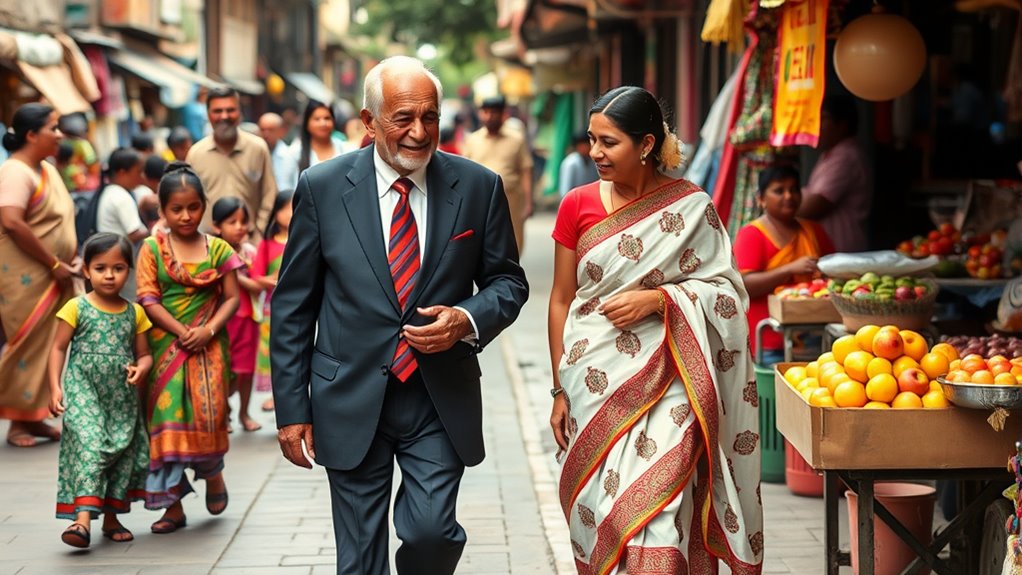Kindness is a universal value, but its expressions differ across cultures. You might see acts like offering help, sharing food, or showing gratitude, which foster trust and community bonds. Gestures such as eye contact, bowing, or gift-giving carry specific cultural meanings. Understanding these local customs helps you connect genuinely and respectfully. If you continue exploring, you’ll discover how diverse acts of kindness strengthen human bonds worldwide.
Key Takeaways
- Acts of offering help, support, and hospitality are universal expressions of kindness, fostering community bonds and mutual trust across cultures.
- Maintaining appropriate eye contact and respectful gestures like bowing or handshakes are shared non-verbal signs of kindness worldwide.
- Sharing food and participating in cultural rituals symbolize care, respect, and social cohesion, highlighting kindness through communal acts.
- Expressing gratitude through words and gestures strengthens relationships and demonstrates appreciation universally.
- Celebrating special occasions with thoughtful gestures and honoring local customs reinforce kindness and cultural connection.
Acts of Offering Help and Support
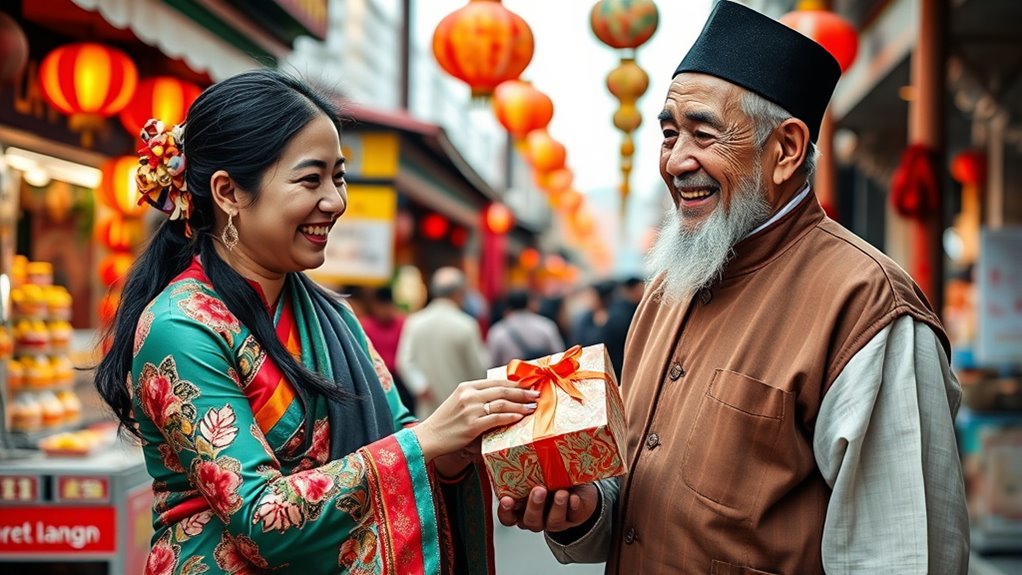
Across cultures, offering help and support is a universal act that reflects kindness and empathy. When you participate in volunteer opportunities, you actively contribute to your community’s well-being. Many cultures emphasize the importance of community outreach, where helping others isn’t just encouraged—it’s expected. Whether you’re assisting at local food banks, helping seniors with daily tasks, or supporting charity events, your actions demonstrate compassion. These acts of offering support foster strong social bonds and promote a sense of shared responsibility. By engaging in community outreach, you not only make a tangible difference but also learn about diverse ways people express kindness. Understanding the significance of community engagement can deepen your appreciation for cultural differences in expressing care. Your willingness to lend a hand reinforces the universal value of caring for others, no matter where you are in the world. Recognizing the digital literacy programs that encourage playful communication among seniors highlights how technology can bridge generational gaps. Additionally, participating in volunteer training programs equips you with essential skills to provide effective support to those in need. Practicing empathy training can further enhance your ability to connect with and support others effectively. Engaging in cultural awareness initiatives can also help you better understand the diverse expressions of kindness across communities.
The Significance of Genuine Eye Contact
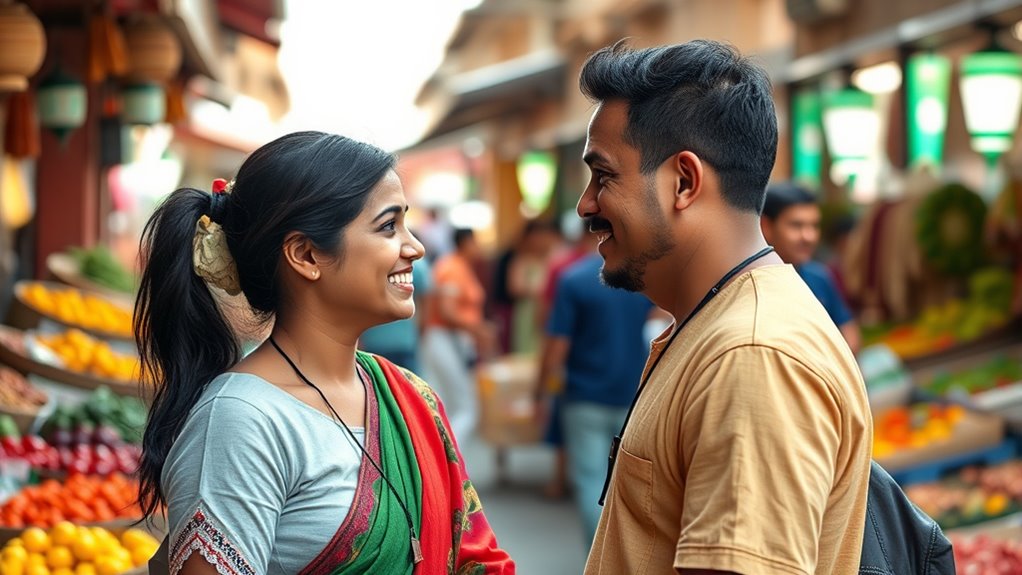
Genuine eye contact plays a crucial role in effective communication because it conveys honesty, attention, and emotional connection. When you make consistent eye contact, you signal that you’re fully present and engaged, which helps build trust. Eye contact allows others to see your sincerity, making your interactions more authentic and meaningful. It’s a universal gesture that fosters trust building across cultures, although its intensity and duration may vary. By maintaining appropriate eye contact, you demonstrate confidence and respect, encouraging openness from others. Avoiding eye contact can seem dismissive or evasive, while too much may feel intrusive. Striking the right balance helps you create a genuine connection, reinforcing kindness and understanding in any cultural setting. Trust is strengthened when eye contact aligns with cultural norms and personal comfort. Recognizing the cultural differences in eye contact practices can prevent misunderstandings and foster more respectful interactions. Incorporating appropriate body language in conjunction with eye contact can further enhance communication and rapport. Being aware of the social context can help you adapt your eye contact style to different situations, making your interactions more effective and respectful. Additionally, understanding how modern influences like social media impact perceptions of eye contact can provide deeper insights into contemporary communication dynamics.
Gestures of Respect and Deference
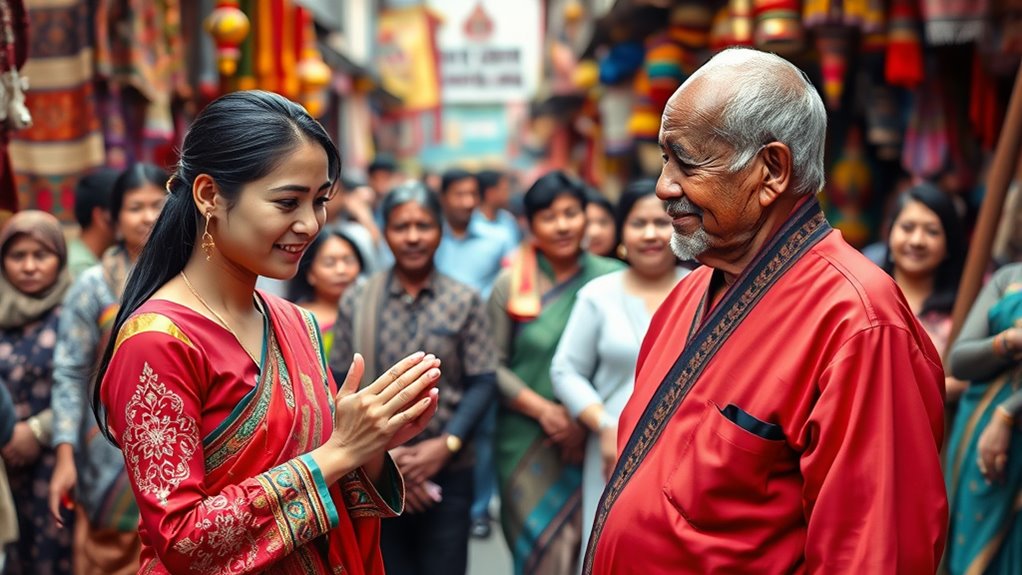
Have you ever wondered how people show respect through their gestures? Bowing gestures and handshaking customs are common ways to express deference across cultures. These actions carry meaning beyond the surface, reflecting humility, trust, or admiration. For example, a slight bow can demonstrate acknowledgment and respect, while a firm handshake signifies agreement and confidence. Incorporating cultural context is essential to understanding the appropriateness of each gesture, highlighting the importance of understanding local customs. Consider these deeper meanings: – Bowing gestures vary in depth and duration, indicating different levels of respect. – Handshakes can be formal or casual, depending on societal norms. – Maintaining eye contact during these gestures shows sincerity. Additionally, understanding the self watering plant pots system can deepen appreciation of how consistent care and attention foster growth, much like respectful gestures nurture positive relationships. The design and material of these watering pots can influence how well they support plant health, paralleling how cultural gestures can support social harmony. Recognizing the traditional tea ceremony can also reveal how rituals of respect and mindfulness are expressed through specific practices and gestures within different cultures. These gestures serve as universal symbols of kindness and respect, adapted to local expressions worldwide.
Sharing Food and Hospitality
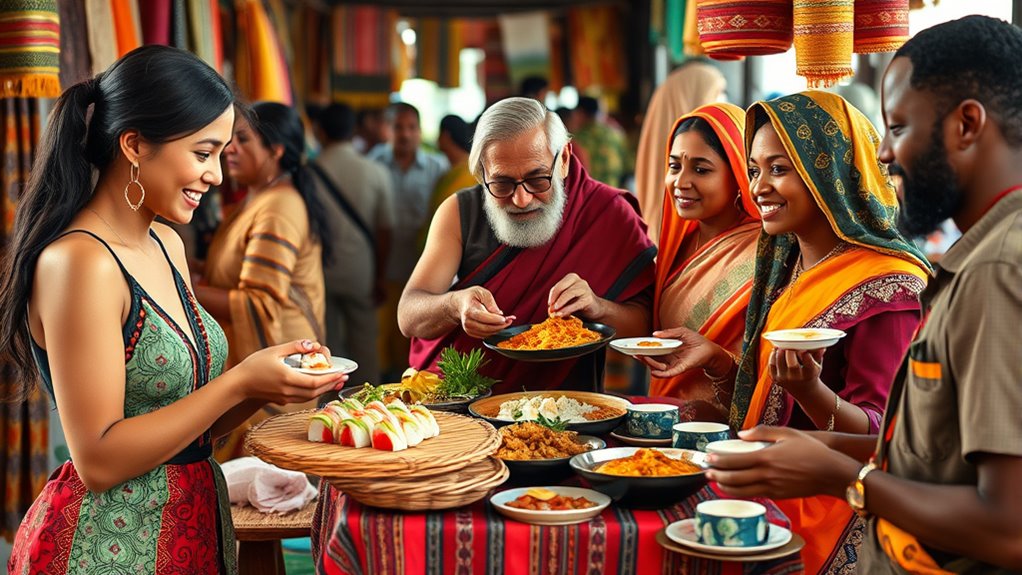
When you share a meal in different cultures, it often symbolizes more than just eating together; it reflects deeper traditions and values. Hospitality is seen as a gift, showing respect and building trust between people. Understanding these food rituals highlights how sharing meals fosters kindness across diverse communities. In some cases, sharing food can also serve as a way to demonstrate cultural security and strengthen social bonds. Additionally, the act of sharing meals often involves community engagement, which reinforces social cohesion and mutual support. Recognizing the importance of active listening during these exchanges can further deepen connections and foster empathy across cultural boundaries. Such practices are often rooted in regional traditions, emphasizing the significance of shared customs and rituals in promoting harmony.
Cultural Food Rituals
Across many cultures, sharing food and hospitality serve as powerful expressions of kindness that foster connection and trust. Cultural food rituals highlight this, emphasizing the importance of food preparation and dining etiquette as acts of respect and care. These rituals often involve specific gestures, like offering a first bite or waiting for everyone to be served, symbolizing unity and gratitude. By participating in these customs, you acknowledge local traditions and deepen relationships. Proper size and dimensions of serving portions and utensils can enhance the dining experience and show attentiveness to cultural preferences. Recognizing symbolic gestures that convey gratitude and humility helps you understand the cultural significance behind simple acts, transforming a meal into a meaningful exchange of kindness and cultural appreciation. Additionally, understanding the best anime movies associated with different cultures can further enrich your appreciation of diverse traditions and storytelling styles.
Hospitality as Gift
Sharing food and extending hospitality transform simple acts into meaningful gifts that express generosity and care. In many cultures, offering a meal or welcoming someone into your home embodies cultural hospitality, highlighting the importance of connection and trust. These gestures often align with gift giving traditions, where the act of sharing becomes a symbol of respect and friendship. By opening your space and sharing your resources, you convey appreciation and foster bonds that transcend words. In some societies, hospitality is viewed as a sacred duty, reinforcing community ties and mutual support. Whether through a shared plate or a warm welcome, these acts serve as universal expressions of kindness, emphasizing that giving and hosting are powerful ways to show you care.
Sharing Meals Significance
Offering a meal or welcoming someone into your home holds deep cultural significance because it fosters connection and trust. Meal sharing and communal dining serve as powerful symbols of friendship, respect, and solidarity across cultures. When you share food, you’re not just nourishing your body; you’re building bonds and demonstrating care. This act often signifies acceptance and openness, creating a safe space for genuine interactions.
- Strengthens social ties and kinship
- Demonstrates generosity and hospitality
- Preserves cultural traditions and identity
- Encourages dialogue and understanding
Participating in communal dining allows you to experience diverse customs and values firsthand. It’s a universal gesture that transcends language, reminding us that kindness often begins with simple acts of sharing.
Expressing Gratitude and Appreciation
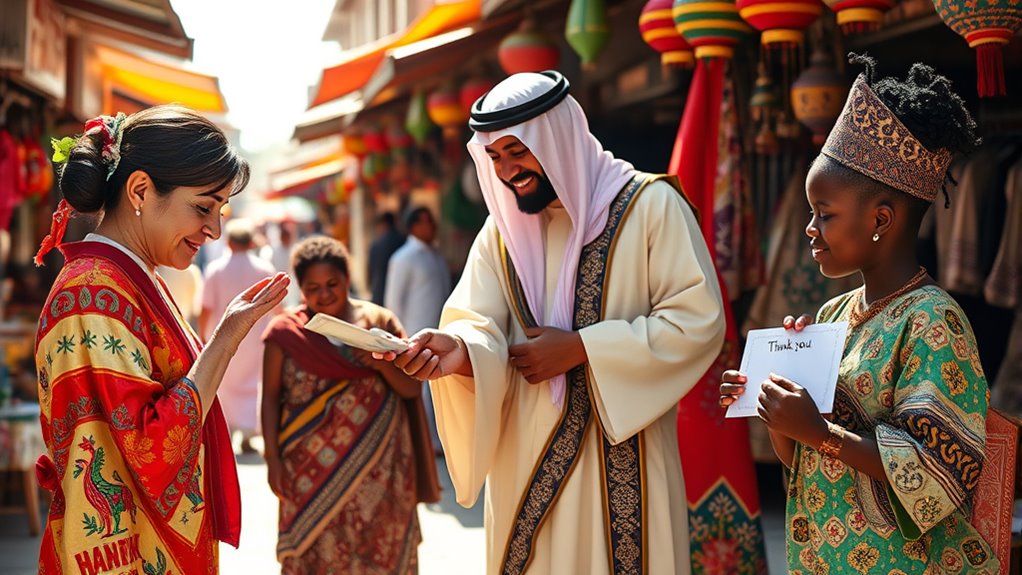
Have you ever wondered why expressing gratitude feels so meaningful in different cultures? It’s because cultural expressions and verbal acknowledgments carry deep significance. In many societies, saying “thank you” isn’t just polite; it’s a essential way to strengthen relationships and show respect. Some cultures have unique gestures or phrases that convey appreciation beyond words, like bowing, a heartfelt hug, or specific blessings. By expressing gratitude, you acknowledge others’ kindness and foster positive bonds. You might notice that in some places, gratitude is expressed loudly and openly, while in others, it’s more subtle and reserved. Regardless of the form, these expressions highlight a universal desire to recognize kindness and build community through simple, genuine acknowledgment.
Comforting Others in Times of Need
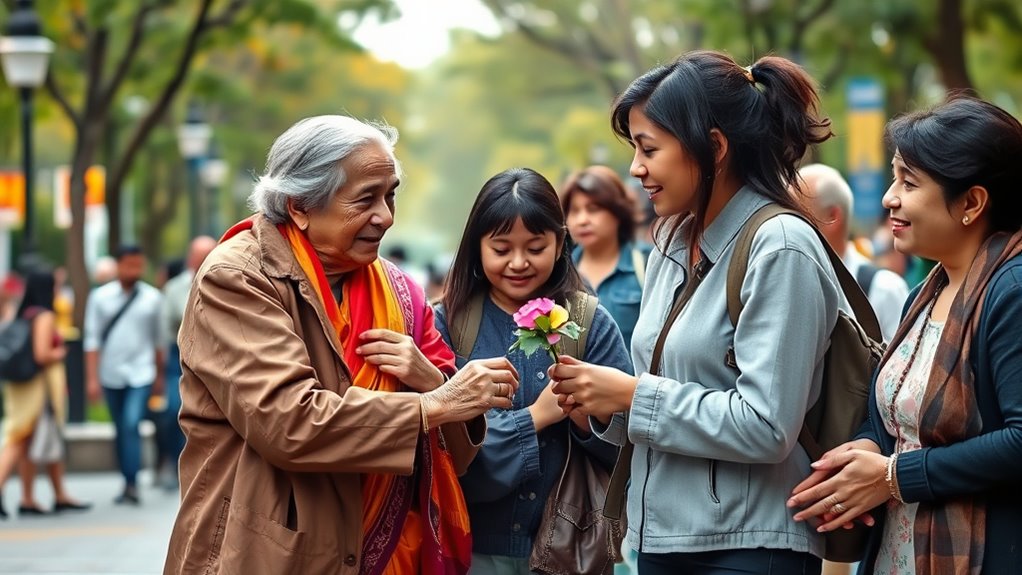
When someone you care about is hurting, the way you offer comfort can vary widely across cultures. You might find that physical gestures, like a hug or a pat, are common in some places, while others prefer words or silent presence. Understanding these differences helps you provide genuine emotional support that truly resonates.
Cultural Comforting Gestures
Across cultures, comforting gestures vary widely, yet their core purpose remains the same: to show support and compassion during times of distress. You might find a gentle touch, a warm hug, or even silent presence as meaningful forms of comfort. Respecting interpersonal boundaries is essential, ensuring your gesture feels appropriate to the situation and individual. Verbal reassurance often accompanies physical gestures, offering words of empathy and understanding. To deepen your connection, consider these cultural nuances:
- A brief touch on the shoulder
- Maintaining eye contact to show sincerity
- Offering quiet companionship rather than words
- Using culturally specific gestures that convey support
Understanding these expressions helps you communicate compassion effectively, honoring both universal kindness and local customs.
Emotional Support Practices
During times of emotional distress, offering genuine support involves more than just physical gestures; it requires actively listening and showing empathy. You help others strengthen their emotional resilience by creating a safe space where they feel heard and understood. Your empathetic responses, whether through words or presence, foster trust and reassurance. As you practice empathy development, you learn to recognize unspoken feelings and respond thoughtfully. This emotional support encourages others to process their pain and rebuild strength. Your genuine concern can make a profound difference, reminding them they’re not alone. By being attentive and compassionate, you help nurture resilience and emotional stability, demonstrating that kindness in times of need transcends cultural boundaries and connects us all through shared human experience.
Celebrating Special Occasions With Kindness
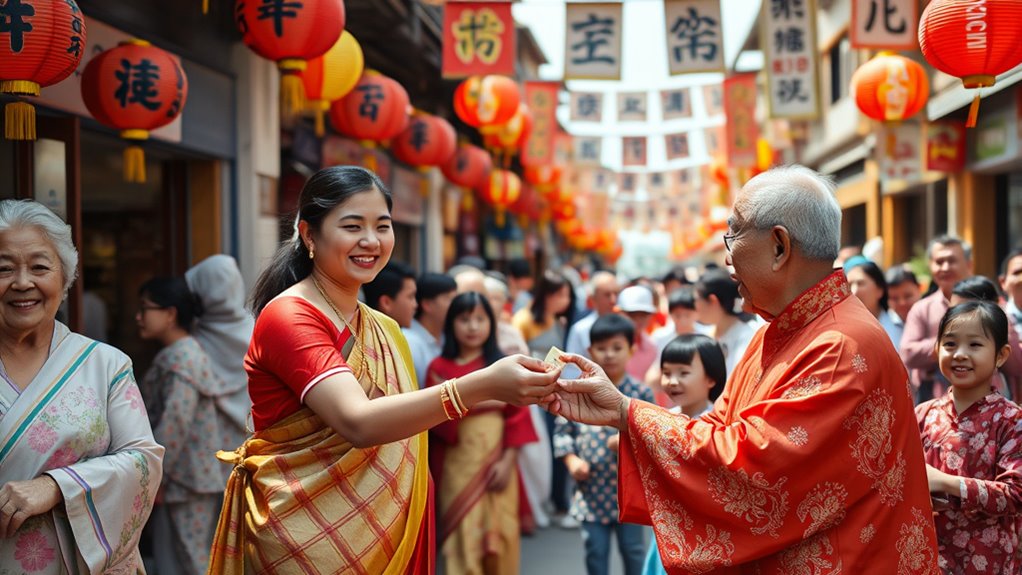
Celebrating special occasions offers a meaningful opportunity to show kindness across cultures. When you participate in these moments, you foster intergenerational bonding and honor local gift giving customs. Sharing traditions like family dinners, community festivals, or religious ceremonies creates a space for connection and mutual respect. Your gestures, whether giving thoughtful gifts or simply offering warm wishes, reinforce kindness’s universal nature.
Consider these aspects:
- Respect cultural norms around gift giving to show thoughtfulness
- Involve elders to strengthen intergenerational bonds
- Embrace local customs to demonstrate cultural appreciation
- Use celebrations to express gratitude and kindness openly
Small Gestures That Make a Big Difference
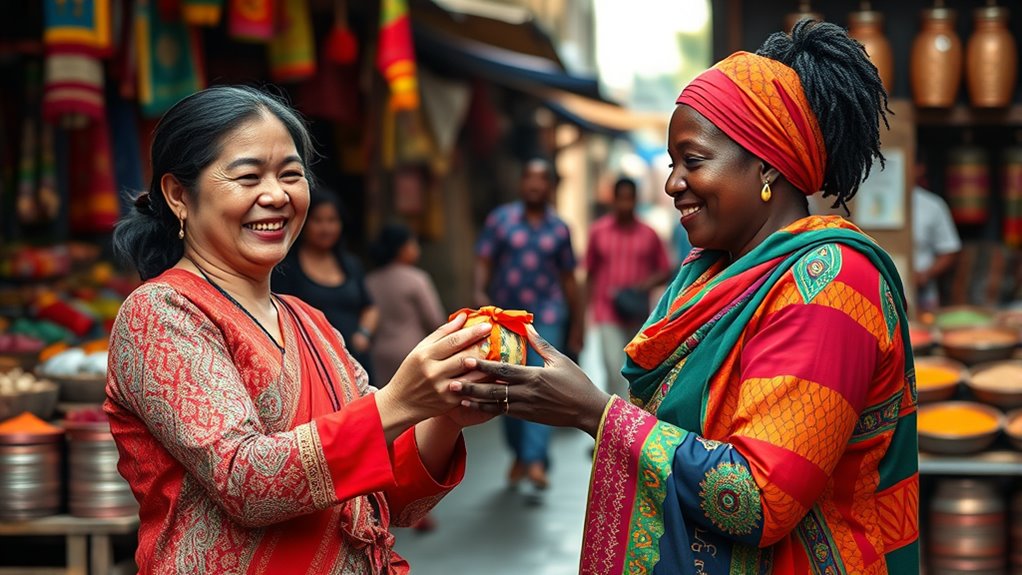
Small gestures have the power to create meaningful connections and brighten someone’s day, often more than grand displays of kindness. Simple random acts, like holding the door or offering a genuine compliment, show you care without expecting anything in return. Small tokens, such as a handwritten note or a favorite snack, can lift spirits unexpectedly. These acts demonstrate thoughtfulness and build trust, making people feel valued and seen. You don’t need to spend much or plan elaborate surprises—what matters is the sincerity behind your actions. When you take the time for these small gestures, you reinforce bonds and foster a culture of kindness that spreads beyond individual moments. Sometimes, the tiniest act can leave a lasting impact.
The Role of Silence and Nonverbal Communication
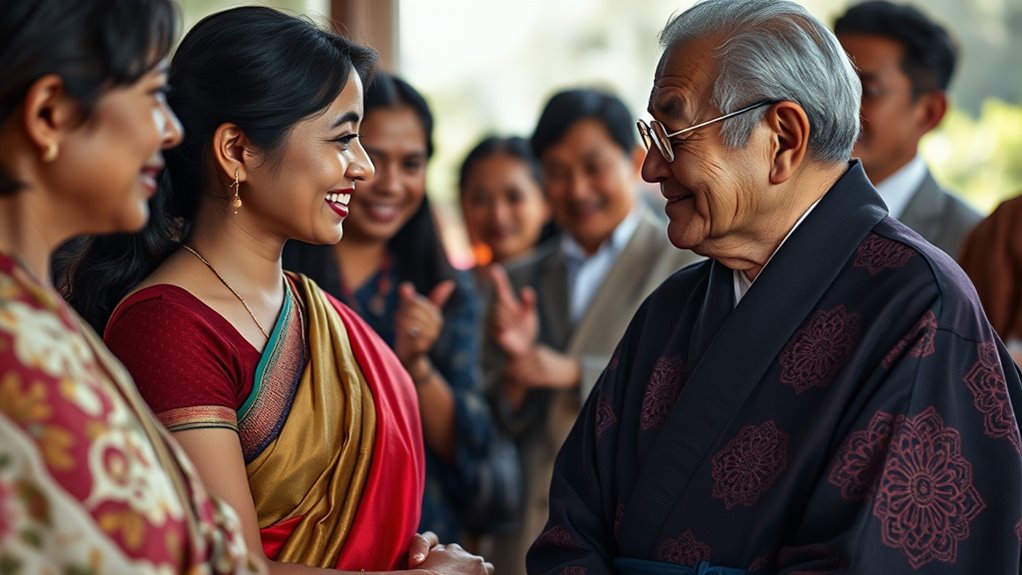
Silence and nonverbal cues often speak louder than words, conveying emotions and intentions that words may fail to express. You might notice that in some cultures, silence as respect holds greater significance, showing reverence or understanding without speech. Facial expressions in communication reveal feelings instantly, often providing more honest insight than spoken words. Nonverbal cues help build trust, demonstrate empathy, and deepen connections across diverse cultural contexts.
- Silence signifies respect and attentiveness
- Facial expressions communicate genuine emotions
- Nonverbal gestures reinforce or soften words
- Cultural differences shape how silence and expressions are interpreted
Frequently Asked Questions
How Do Cultural Norms Influence Expressions of Kindness?
Cultural norms shape how you express kindness by guiding your behavior based on cultural etiquette and social expectations. In some cultures, politeness and indirect gestures are valued, so your kindness might come through subtle actions. In others, directness and gestures like hugs or handshakes are common. You adapt your expressions of kindness to fit these norms, ensuring your actions are appropriate and meaningful within each cultural context.
Are There Universal Symbols of Kindness Across Cultures?
Did you know that 85% of people worldwide recognize a smile as a symbol of kindness? While cross-cultural expressions of kindness vary, some universal symbols like smiling, offering help, or giving a small gift are understood globally. These universal symbols transcend cultural differences, making kindness recognizable and meaningful across cultures. So, yes, certain symbols of kindness are shared worldwide, helping foster understanding and connection beyond local expressions.
How Does Language Shape Acts of Kindness Worldwide?
You might wonder how language influences kindness worldwide. Through linguistic relativity, you see that vocabulary differences shape how people express compassion, gratitude, or help. When words for kindness, respect, or support vary, your understanding and actions can differ too. Language guides your perceptions and responses, making acts of kindness feel more personal or universal based on the words available. So, your language subtly molds how you show and interpret kindness across cultures.
What Role Does Religion Play in Kindness Expressions?
Religion plays a significant role in shaping kindness expressions by inspiring faith-based compassion and guiding actions through religious rituals. You might notice that religious teachings encourage acts of charity, forgiveness, and empathy, which become central to how kindness is demonstrated. These rituals and beliefs motivate you to support others, fostering a sense of community and shared moral responsibility that transcends cultural differences.
Can Cultural Misunderstandings Hinder Acts of Kindness?
Did you know that 60% of intercultural interactions face misunderstandings? Cultural misunderstandings can definitely hinder acts of kindness because differing social etiquette and gesture recognition cause confusion. When you misinterpret a gesture, it can unintentionally offend or create distance. To foster kindness, you need to be aware of cultural differences, learn local social cues, and communicate openly. This awareness helps you navigate kindness across cultures more effectively and respectfully.
Conclusion
When you act with kindness across cultures, it’s like planting seeds in a universal garden. Imagine each gesture—helping, listening, sharing—growing into vibrant blooms that transcend language. Though expressions differ, the essence remains: kindness blooms everywhere, connecting hearts silently like roots beneath the surface. Your small acts, no matter where you are, ripple outward, reminding us all that genuine care is a language everyone understands without a word.
